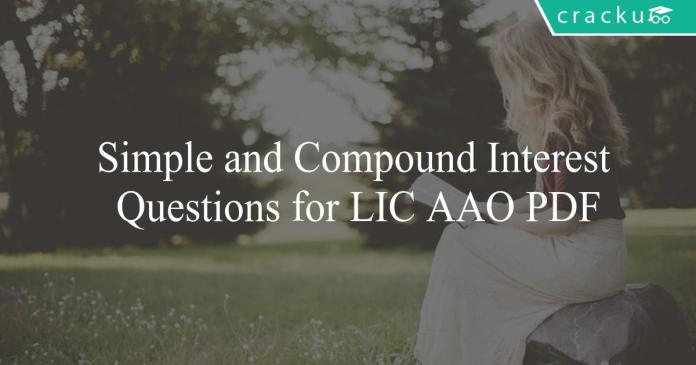Simple and Compound Interest Questions for LIC AAO PDF:
Download Important Simple Compound Intrest questions for LIC AAO exam. Top 10 Simple and Compound Interest questions with answers based on previous year asked questions.
Download LIC AAO PDF Interest Questions PDF
Take a free mock test for LIC AAO
Download LIC AAO Previous Papers PDF
Question 1: The compound interest accrued on an amount of Rs. 22,000 at the end of two years is Rs. 5,596.8. What would be the simple interest accrued on the same amount at the same rate in the same period ?
a) Rs.5,420
b) Rs.5 360
c) Rs.5,280
d) Rs.5. 140
e) None of these
Question 2: An interest of Rs. 8384 is received when a certain sum is invested for 4 years in scheme A which offers simple interest at 8% per annum. When the same sum of money is invested for 6 years in scheme B which also offers simple interest at a certain rate, the amount received is Rs. 39562, what is the rate of interest offered by scheme B ?
a) 8.5
b) 7.25
c) 7.5
d) 8.25
e) 9.5
Question 3: A certain sum is invested for 2 years in scheme A at 20% p.a. compound interest compounded annually. Same sum is also invested for the same period in scheme B at x%p.a. to a simple interest earned from scheme A is twice of that earned from scheme B. What is the value of x ?
a) 10
b) 11
c) 15
d) 12
e) 19
Download LIC AAO Previous Papers PDF
100 Free Computer Awareness Tests for LIC
Question 4: Out of Rs. 8000, Gopal invested a certain sum in scheme A and the remaining sum in scheme B for two years. Both the schemes offer compound interest (compunded annually). The rate of interest of scheme A and B are 10 p.c.p.a. and 20 p.c.p.a. respectively. If the total amount accrued by him after two years from both the schemes together was Rs. 10,600, what was the amount invested in scheme B ?
a) Rs. 4200
b) Rs. 4800
c) Rs. 5200
d) Rs. 3600
e) Rs. 4000
Question 5: What will be the compound interest on a sum of Rs. 9000 at compound interest compounded annually at 8% per annum in two years ?
a) Rs. 1498.76
b) Rs. 1497.6
c) Rs. 1597.6
d) Rs. 1480.60
e) None of these
Question 6: Find the true discount on a bit for Rs. 1270 due in 7 months hence at 10% per annum.
a) Rs. 1050
b) Rs. 110
c) Rs. 1120
d) Rs. 70
Instructions
Calculate the quantity I and the quantity II on the basis of the given information then compare them and answer the following questions accordingly.
Question 7: Quantity 1: Simple interest charged by a bank on a sum of Rs. 1000 at the rate of 22% annum for 2 years.
Quantity 2: Compound interest charged by another bank on a sum of Rs. 1000 at the rate of 20% annum for 2 years compounded annually.
a) Quantity 1 > Quantity 2
b) Quantity 1 $\geq$ Quantity 2
c) Quantity 1 < Quantity 2
d) Quantity 1 $\leq$ Quantity 2
e) Quantity 1 = Quantity 2
100 Free GK Tests for Insurance Exams
Question 8: If the difference in compound interest and simple interest at 20% per annum in two years for certain sum is 80. Then find the difference in the compound and simple interest on the same sum at 10% annum after 3 years?
a) 60
b) 68
c) 75
d) 62
e) 55
Question 9: The difference between the compound interest and simple interest on a sum for a period of 3 years at 20% per annum is Rs. 256. What is the principal amount?
a) 3000
b) 2000
c) 4000
d) 5000
e) None of these
Question 10: Krishna borrows Rs. 10,000 from a bank at 10% per annum compounded annually. He returned the sum in 2 equal installments at the end of first year and second year. Find out the amount he paid in each installment?
a) 5500
b) 5671.90
c) 6000
d) 5761.90
e) 5840.90
LIC AAO REASONING QUESTIONS PDF
Answers & Solutions:
1) Answer (C)
C.I. = $Rs. 5,596.8$
=> $P [(1 + \frac{R}{100})^T – 1] = 5596.8$
=> $22,000 [(1 + \frac{R}{100})^2 – 1] = 5596.8$
=> $[(1 + \frac{R}{100})^2 – 1] = \frac{5596.8}{22000} = 0.2544$
=> $(1 + \frac{R}{100})^2 = 0.2544 + 1 = 1.2544$
=> $1 + \frac{R}{100} = \sqrt{1.2544} = 1.12$
=> $\frac{R}{100} = 1.12 – 1 = 0.12$
=> $R = 0.12 \times 100 = 12 \%$
$\therefore S.I. = \frac{P \times R \times T}{100}$
= $\frac{22000 \times 12 \times 2}{100}$
= $220 \times 24 = Rs. 5,280$
2) Answer (A)
Let principal amount in both schemes = $Rs. P$
In scheme A, time = 4 years and rate = 8% under simple interest.
=> $S.I. = \frac{P \times R \times T}{100}$
=> $8384 = \frac{P \times 8 \times 4}{100}$
=> $P = \frac{8384 \times 100}{32} = Rs. 26,200$
In scheme B, time = 6 years and amount received under simple interest = Rs. 39,562
Principal amount = Rs. 26,200
Interest = 39562 – 26200 = Rs. 13,362
Let rate of interest = $r \%$
=> $S.I. = \frac{P \times R \times T}{100}$
=> $13362 = \frac{26200 \times r \times 6}{100}$
=> $r = \frac{13362}{262 \times 6} = \frac{51}{6}$
=> $r = 8.5 \%$
3) Answer (B)
Let sum invested in both schemes = $Rs. P$
Let interest earned in scheme A = $Rs. 2x$
In scheme A, time = 2 years and rate = 20% under compound interest.
=> $C.I. = P [(1 + \frac{R}{100})^T – 1]$
=> $2x = P [(1 + \frac{20}{100})^2 – 1]$
=> $2x = P [(\frac{6}{5})^2 – 1]$
=> $2x = P (\frac{36}{25} – 1) = \frac{11 P}{25}$
=> $x = \frac{11 P}{50}$ ———–(i)
Now, in scheme B, interest earned = $Rs. x$
Time = 2 years and rate of interest = $x \%$ under simple interest
=> $S.I. = \frac{P \times R \times T}{100}$
=> $x = \frac{P \times x \times 2}{100}$
Using, equation(i), we get :
=> $\frac{11 P}{50} = \frac{P \times x}{50}$
=> $x = 11 \%$
4) Answer (E)
Let the amount invested in scheme B = $Rs. x$
=> Amount invested in scheme A = $Rs. (8,000 – x)$
The rate of interest of scheme A and B are 10 p.c.p.a. and 20 p.c.p.a. respectively
Also, amount under C.I. = $P (1 + \frac{R}{100})^T$
=> $[x (1 + \frac{10}{100})^2] + [(8000 – x) (1 + \frac{20}{100})^2] = 10,600$
=> $x (\frac{11}{10})^2 + (8000 – x) (\frac{6}{5})^2 = 10600$
=> $\frac{121 x}{100} + 11520 – \frac{36 x}{25} = 10600$
=> $\frac{23 x}{100} = 11520 – 10600 = 920$
=> $x = 920 \times \frac{100}{23} = 40 \times 100$
=> $x = Rs. 4,000$
5) Answer (B)
Principal amount, $P = Rs. 9,000$
Time = 2 years and rate of interest = 8% under compound interest
=> $C.I. = P [(1 + \frac{R}{100})^T – 1]$
= $9000 [(1 + \frac{8}{100})^2 – 1]$
= $9000 [(\frac{27}{25})^2 – 1] = 9000 (\frac{729}{625} – 1)$
= $9000 \times \frac{104}{625}$
= $14.4 \times 104 = Rs. 1,497.6$
6) Answer (D)
Amount = Rs. 1,270
Let true discount (interest) = Rs. x
=> Principal = $Rs. (1270 – x)$
Time = 7 months and rate = 10 %
$\therefore \frac{(1270 – x) \times 10 \times \frac{7}{12}}{100} = x$
=> $(1270 – x) \times \frac{7}{12} = 10x$
=> $(1270 \times 7) – 7x = 120x$
=> $1270 \times 7 = 120x + 7x = 127x$
=> $x = \frac{1270 \times 7}{127}$
=> $x = 10 \times 7 = Rs. 70$
7) Answer (E)
Simple interest paid to bank = 1000*.22*2 = Rs. 440
Compound interest paid to bank = $1000(1 + \dfrac{20}{100})^2 – 1000$ = Rs. 440
Hence, we can say that Quantity 1 = Quantity 2. Option E is the correct answer.
8) Answer (D)
Let us assume ‘P’ is the principal which is borrowed.
Simple interest accrued in 2 years = $\frac{P * 20 * 2}{100}$ = 0.4P
Compound interest accrued in 2 years = P *$(1 + \frac{20}{100} )^{2}$ – P = 0.44P
Difference between compound and simple interest = 0.44P – 0.4P = 0.04P
$\Rightarrow$ 80 = 0.04 P
$\Rightarrow$ P = 2000
Simple interest accrued in 3 years at 10% per annum = $\frac{2000 * 10 * 3}{100}$ = 600
Compound interest accrued in 3 years at 10% per annum = 2000 *$(1 + \frac{10}{100} )^{3}$ – 2000 = 662
So the difference in C.I. and S.I. at 10% annum after 3 years = 662-600 = 62
9) Answer (B)
Let assume the principal amount = X
Simple interest for 3 years = $\frac{Principal*Rate*Time}{100}$ = $\frac{X*20*3}{100}$ = 0.6X
Compound interest payable for 3 years = X*$(1+\frac{20}{100})^{3}$-X = 0.728X
Difference between compound and simple interest = 0.728X – 0.6X = 0.128X
$\Rightarrow$ 0.128X = 256
$\therefore$ X = 2000 (ans)
10) Answer (D)
Let us assume Krishna paid x rupees in each instalment then at the end of first year
Principal amount = 10000, Interest payable = $\frac{10}{100}*10000$ = 1000
Principle amount left for second year = total payable at end of first year – instalment amount
$\Rightarrow$ 10000+1000 – x = 11000 – x
Taking second year into consideration
Interest payable = $\frac{10}{100}*(11000 – x)$ = 1100 – 0.1x
So second instalment = Principal amount + interest = x
$\Rightarrow$ (11000 – x) + (1100 – 0.1x) = x
$\Rightarrow$ 12100 = 2.1x
$\Rightarrow$ x = 5761.90
Hence we can say that Krishna paid 5761.90 rupees in each instalment.





